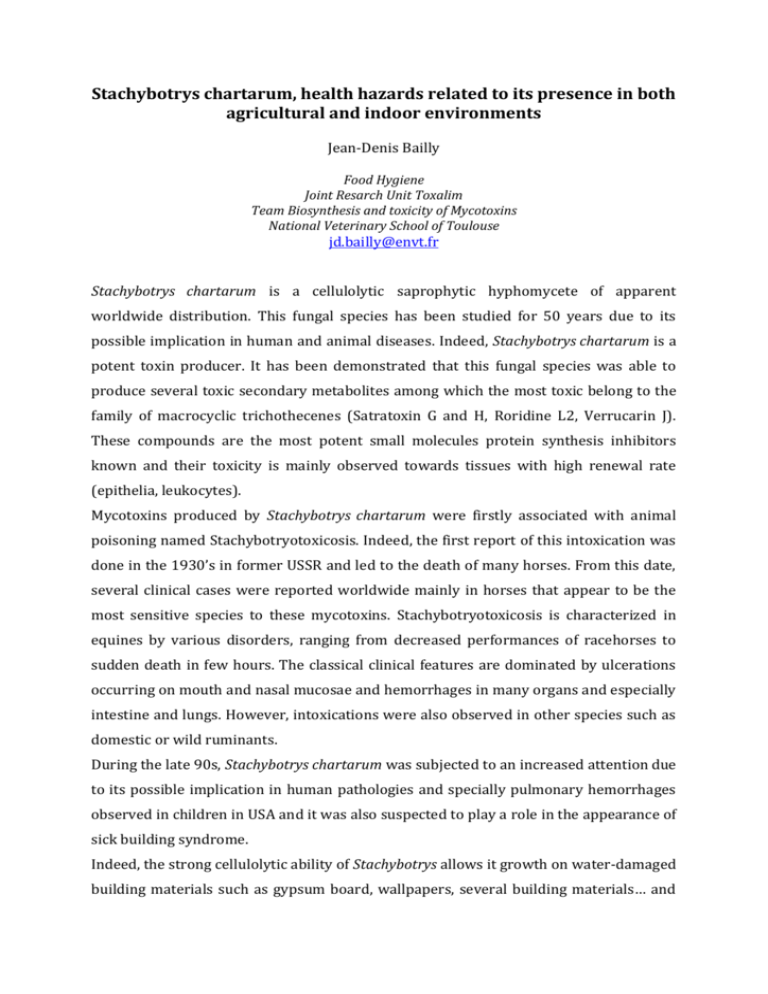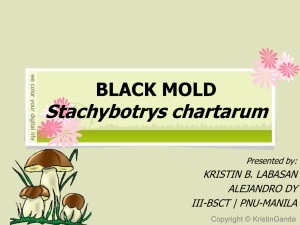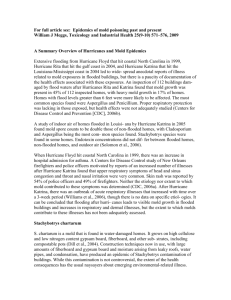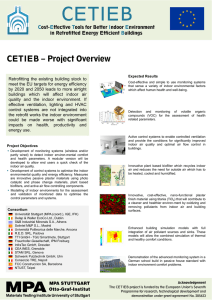abstract
advertisement

Stachybotrys chartarum, health hazards related to its presence in both agricultural and indoor environments Jean-Denis Bailly Food Hygiene Joint Resarch Unit Toxalim Team Biosynthesis and toxicity of Mycotoxins National Veterinary School of Toulouse jd.bailly@envt.fr Stachybotrys chartarum is a cellulolytic saprophytic hyphomycete of apparent worldwide distribution. This fungal species has been studied for 50 years due to its possible implication in human and animal diseases. Indeed, Stachybotrys chartarum is a potent toxin producer. It has been demonstrated that this fungal species was able to produce several toxic secondary metabolites among which the most toxic belong to the family of macrocyclic trichothecenes (Satratoxin G and H, Roridine L2, Verrucarin J). These compounds are the most potent small molecules protein synthesis inhibitors known and their toxicity is mainly observed towards tissues with high renewal rate (epithelia, leukocytes). Mycotoxins produced by Stachybotrys chartarum were firstly associated with animal poisoning named Stachybotryotoxicosis. Indeed, the first report of this intoxication was done in the 1930’s in former USSR and led to the death of many horses. From this date, several clinical cases were reported worldwide mainly in horses that appear to be the most sensitive species to these mycotoxins. Stachybotryotoxicosis is characterized in equines by various disorders, ranging from decreased performances of racehorses to sudden death in few hours. The classical clinical features are dominated by ulcerations occurring on mouth and nasal mucosae and hemorrhages in many organs and especially intestine and lungs. However, intoxications were also observed in other species such as domestic or wild ruminants. During the late 90s, Stachybotrys chartarum was subjected to an increased attention due to its possible implication in human pathologies and specially pulmonary hemorrhages observed in children in USA and it was also suspected to play a role in the appearance of sick building syndrome. Indeed, the strong cellulolytic ability of Stachybotrys allows it growth on water-damaged building materials such as gypsum board, wallpapers, several building materials… and Stachybotrys chartarum has been identified as a frequent contaminant of indoor environments. It raised the hypothesis of a possible exposure of inhabitants to macrocyclic trichothecenes by inhalation of spores or contaminated dusts and recently, it was demonstrated the frequent presence of macrocyclic trichothenes in urine from patients suffering from chronic fatigue syndrome. Our works aimed to: - characterize the nature of Stachybotrys isolates that could contaminate both hay and indoor environments as well as their toxigenic potential. Indeed, during last years we noted an increase in equine intoxication with macrocyclic trichothecenes, possibly related to change in agricultural practices. - evaluate the ability of a toxigenic strain to develop and produce macrocyclic trichothecenes on different indoor materials - study the possible aerosolization of these mycotoxin from contaminated materials to provide new insight into risk assessment related to the presence of such contaminant.







